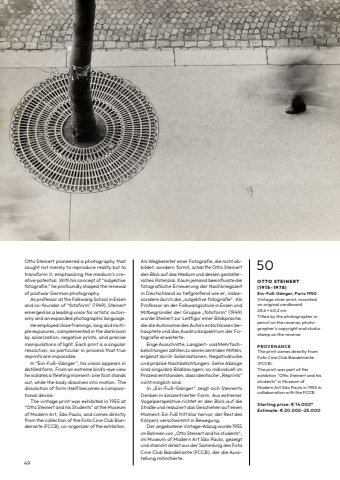Page 51 - Demo
P. 51
4950O T T O S T E I N E R T (1915%u20131978)Ein-Fu%u00df-G%u00e4nger, Paris 1950Vintage silver print, mounted on original cardboard28,6 %u00d7 40,2 cmTitled by the photographer in pencil on the reverse, photographer%u2019s copyright and studiostamp on the reversePROV E N AN C E The print comes directly from Foto Cine Club Bandeirante (FCCB).The print was part of the exhibtion %u201cOtto Steinert and his students%u201d in Museum of Modern Art S%u00e3o Paulo in 1955 in collaboration with the FCCB.Starting price: %u20ac 14.000*Estimate: %u20ac 20.000%u201325.000Als Wegbereiter einer Fotografie, die nicht abbildet, sondern formt, sch%u00e4rfte Otto Steinert den Blick auf das Medium und dessen gestalterisches Potenzial. Kaum jemand beeinflusste die fotografische Erneuerung der Nachkriegszeit in Deutschland so tiefgreifend wie er, insbesondere durch die %u201esubjektive fotografie%u201c. Als Professor an der Folkwangschule in Essen und Mitbegr%u00fcnder der Gruppe %u201efotoform%u201c (1949) wurde Steinert zur Leitfigur einer Bildsprache, die die Autonomie des Autors entschlossen behauptete und das Ausdrucksspektrum der Fotografie erweiterte.Enge Ausschnitte, Langzeit- und Mehrfachbelichtungen z%u00e4hlten zu seinen zentralen Mitteln, erg%u00e4nzt durch Solarisationen, Negativdrucke und pr%u00e4zise Nachbelichtungen. Seine Abz%u00fcge sind singul%u00e4re Bildl%u00f6sungen: so individuell im Prozess entstanden, dass identische %u201eReprints%u201c nicht m%u00f6glich sind.In %u201eEin-Fu%u00df-G%u00e4nger%u201c zeigt sich Steinerts Denken in konzentrierter Form. Aus extremer Vogelperspektive richtet er den Blick auf die Stra%u00dfe und reduziert das Geschehen auf einen Moment: Ein Fu%u00df tritt klar hervor, der Rest des K%u00f6rpers verschwimmt in Bewegung.Der angebotene Vintage-Abzug wurde 1955 im Rahmen von %u201eOtto Steinert and his students%u201c, im Museum of Modern Art S%u00e3o Paulo, gezeigt und stammt direkt aus der Sammlung des Foto Cine Club Bandeirante (FCCB), der die Ausstellung mitinitiierte.Otto Steinert pioneered a photography that sought not merely to reproduce reality but to transform it, emphasizing the medium%u2019s creative potential. With his concept of %u201csubjektive fotografie,%u201d he profoundly shaped the renewal of postwar German photography.As professor at the Folkwang School in Essen and co-founder of %u201cfotoform%u201d (1949), Steinert emerged as a leading voice for artistic autonomy and an expanded photographic language.He employed close framings, long and multiple exposures, complemented in the darkroom by solarization, negative prints, and precise manipulations of light. Each print is a singular resolution, so particular in process that true reprints are impossible.In %u201cEin-Fu%u00df-G%u00e4nger%u201d, his vision appears in distilled form. From an extreme bird%u2019s-eye view he isolates a fleeting moment: one foot stands out, while the body dissolves into motion. The dissolution of form itself becomes a compositional device.The vintage print was exhibited in 1955 at %u201cOtto Steinert and his Students%u201d at the Museum of Modern Art, S%u00e3o Paulo, and comes directly from the collection of the Foto Cine Club Bandeirante (FCCB), co-organizer of the exhibition.


